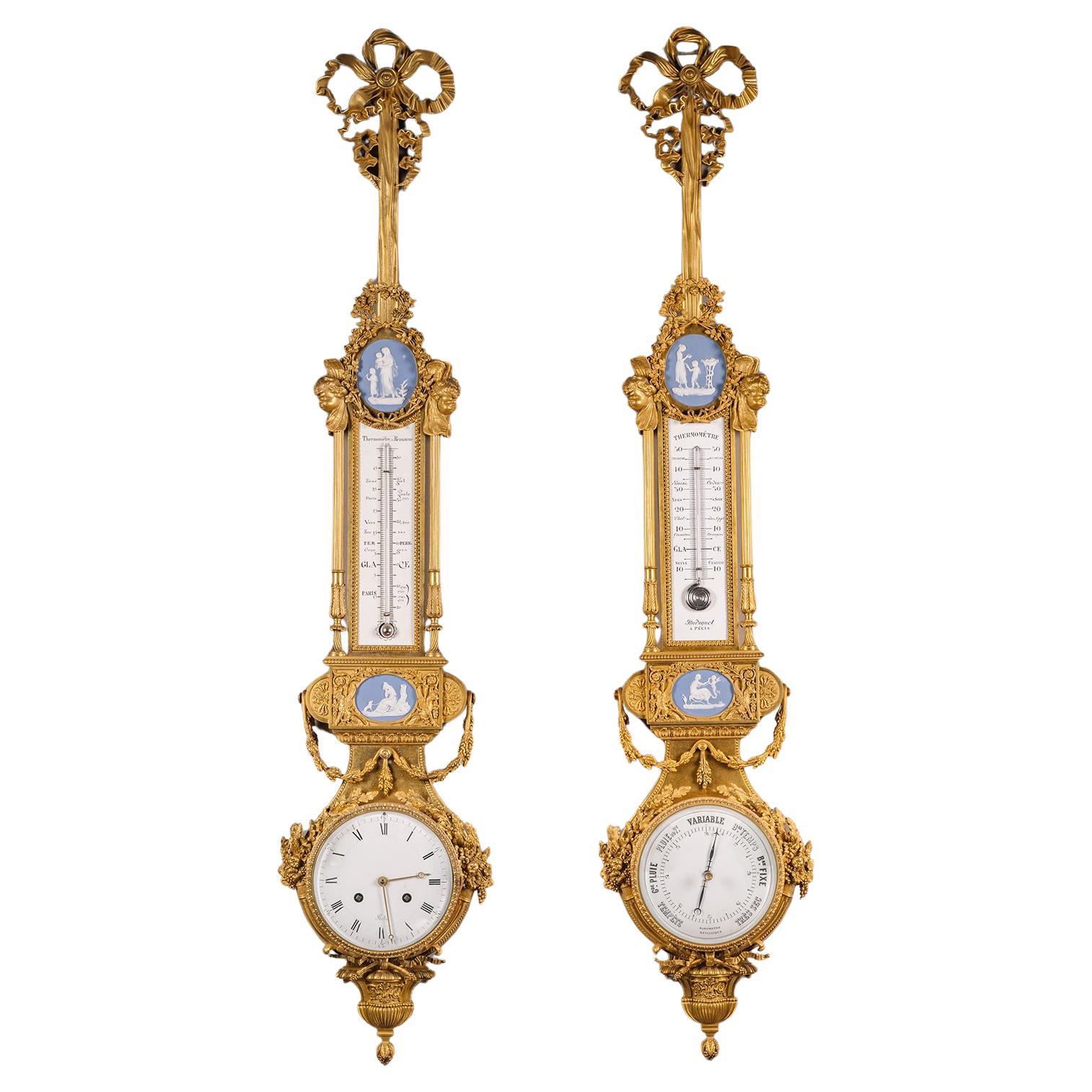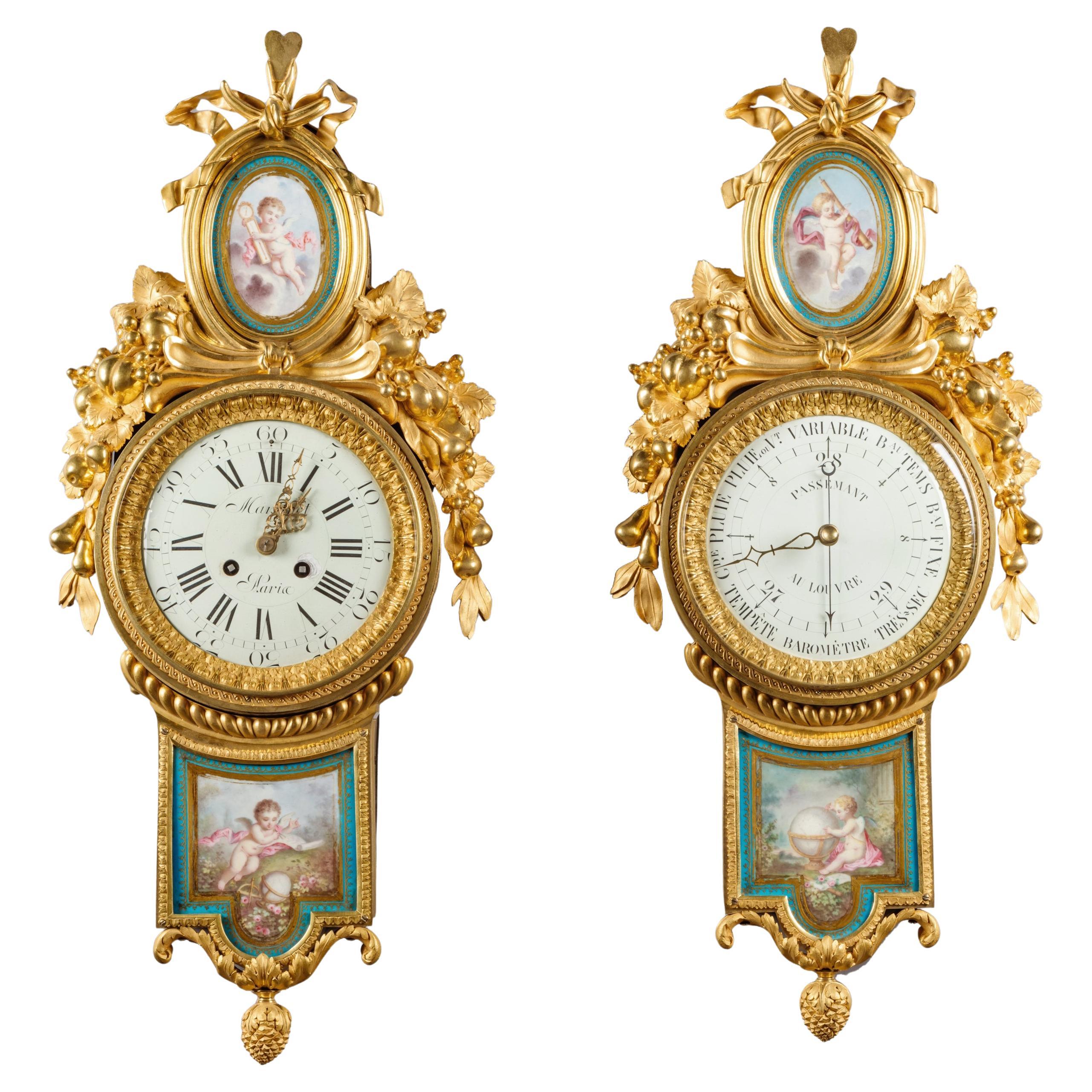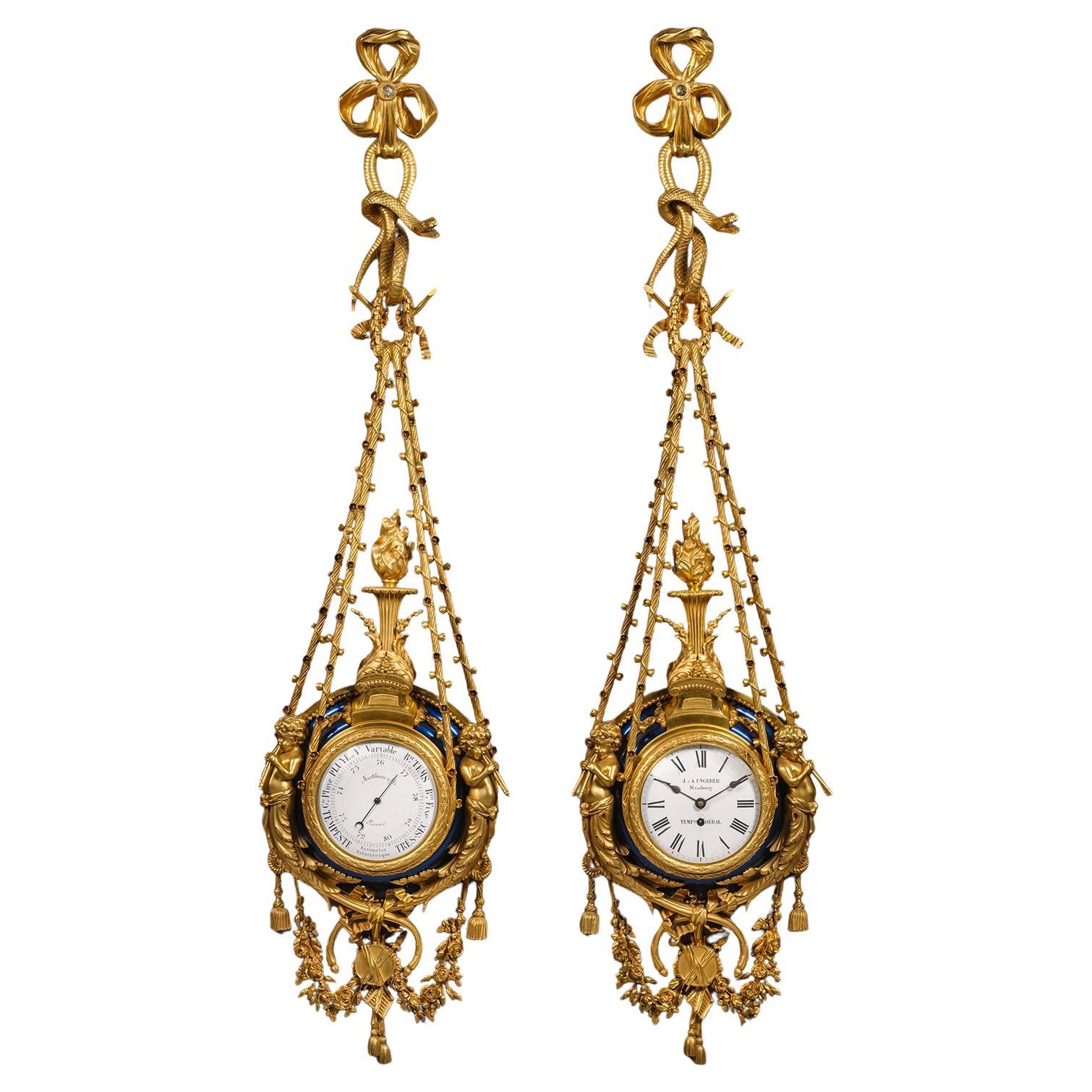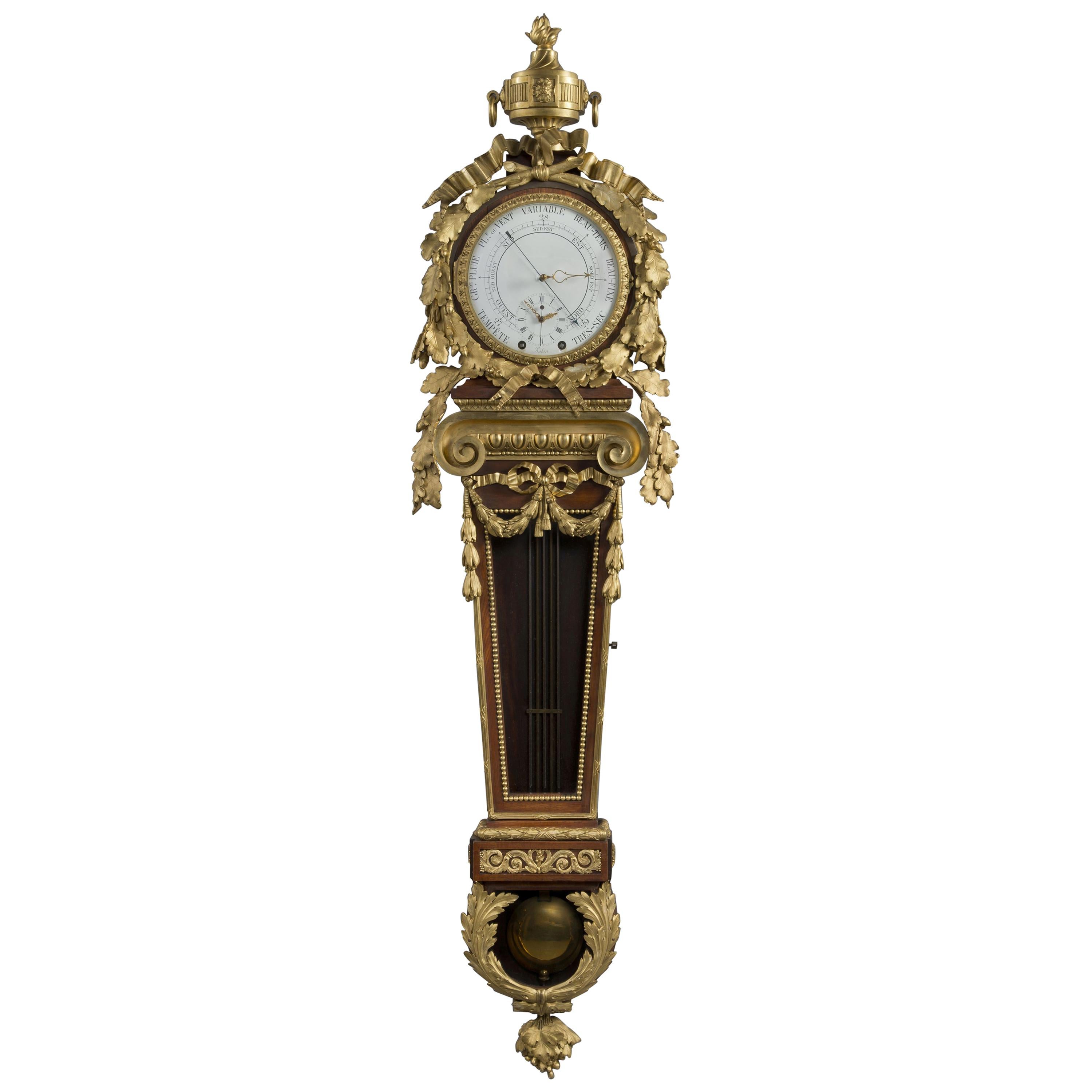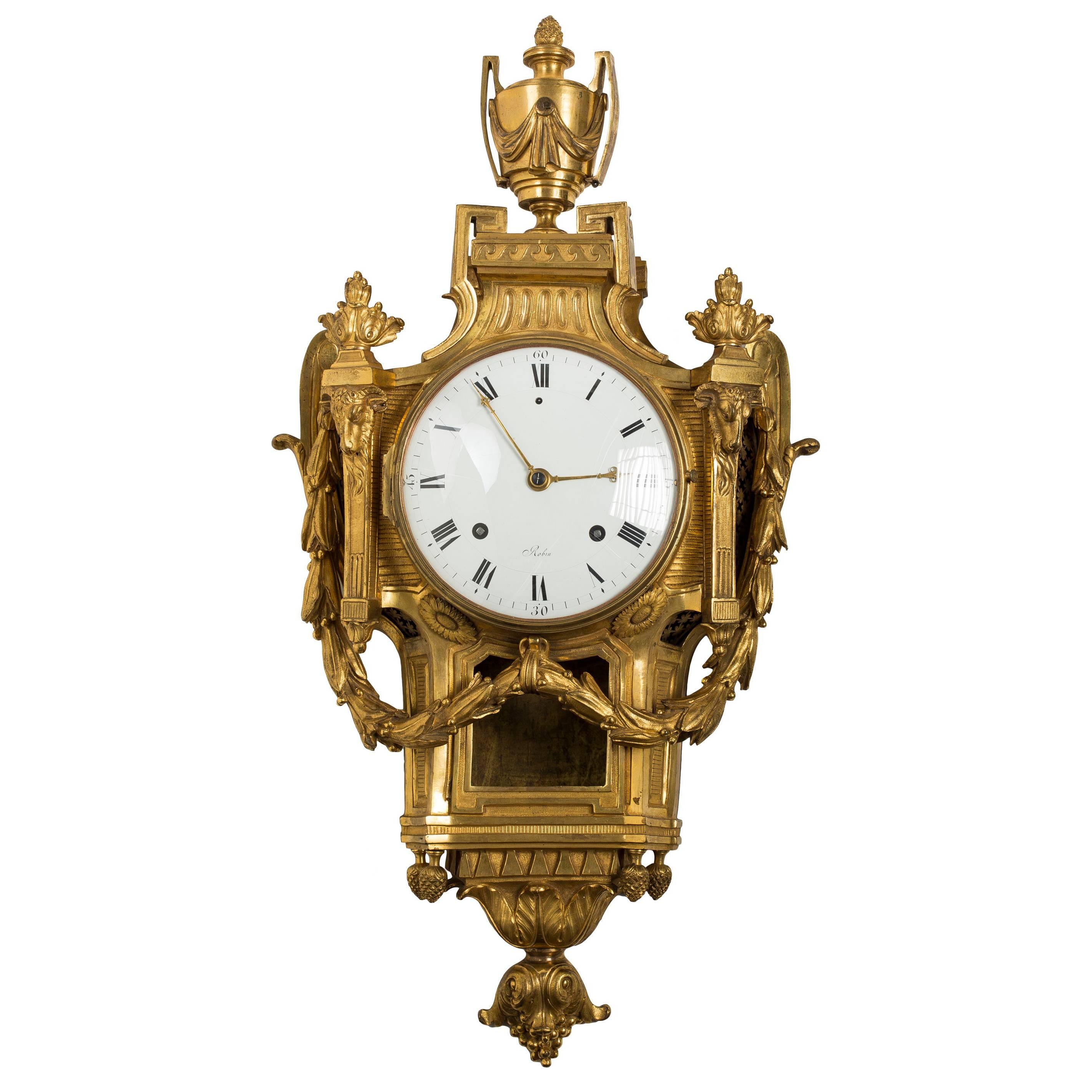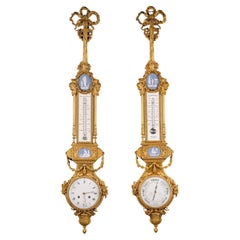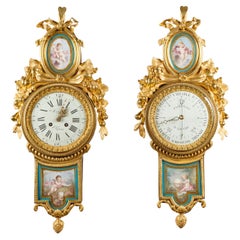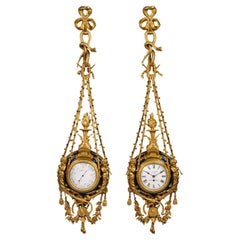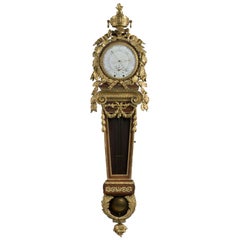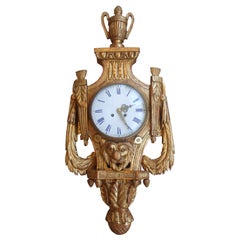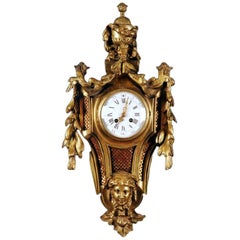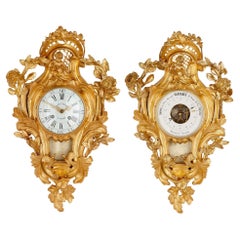Artículos similares a A Louis XVI Style Cartel Clock and Companion Barometer
¿Quieres más imágenes o vídeos?
Solicita imágenes o vídeos adicionales al vendedor
1 de 13
A Louis XVI Style Cartel Clock and Companion Barometer
Acerca del artículo
A Louis XVI Style Gilt-Bronze and Jasperware Mounted Cartel Clock and Companion Barometer, After the Model Attributed to Pierre Gouthière.
The clock and barometer each surmounted by accompanying thermometers, jasperware plaques and ribbon tied finials. The gilt-bronze cases embellished with garlands of roses, cornucopia, fruiting vines and oak leaves in reference to the four seasons. Flanking the upper Jasperware plaque - two heads with delicate wings personifying the wind.
The clock with white enamelled dial, hours marked in Roman numerals and seconds in divisions of five in Arabic numerals. The eight-day twin-train movement with anchor escapement striking half and full hours on a bell, stamped with the number '80'. The companion aneroid barometer with conforming white enamel dial indicating barometric range TEMPETE, Gx Pluie, Pluie Ou VARIABLE, Beau Temps, Beau Fixe, TRES SEC, (Stormy, Rainy Variable, Nice Weather, Fair Weather and Very Dry). The thermometers marked with the Réaumur scale. The thermometer set above the barometer, consists of an alcohol filled glass thermometer capillary tube with a scale running from 25 degrees below zero to 35 degrees above, following the Réaumur scale.
The unusually cold temperatures attained in Paris during the winter of 1785 are indicated on the two thermometers and explains the extremes of the scale used.
The present cartel clock and matching barometer are based on a model attributed to the bronzier Pierre-Joseph-Désiré Gouthière (d. 1813), originally from the Château de Saint-Cloud and now part of the permanent collection at the Musée du Louvre (OA 5493 and OA 5494).
Stamped 'P G' to the back of the bronze in the cast.
French, Circa 1880.
In the second half of the 19th century, furniture and works of art, once the preserve of the aristocracy and often literally made for royalty, were transferred, often through war and revolution, to state museum collections, many via pioneering private collectors. Before this time, there were very few museums.
The examples in the Louvre (shown in an old black and white photograph), attributed to the bronze maker Pierre Gouthière and the horloger Carcany, were made circa 1785 for a member of Louis XVI’s court, very possibly for Queen Marie Antoinette herself. By the mid-19th century, they were at the Château de Saint-Cloud, perhaps in the Salon of Empress Eugenie. With the fall of the Second Empire, they were transferred to the Musée du Louvre, where they were properly documented, photographed, published, and exhibited.
The fashion for the Ancien Régime and ‘tous les Louis’ drove a new breed of collectors, such as Sir Richard Wallace and Henry Clay Frick. Public exhibitions of royal furniture and works of art gave contemporary makers the opportunity to examine these masterpieces up close for the first time. Makers competed to produce the most magnificent replicas, and versions of these clocks and barometers were exactingly made during the late 19th century.
Literature:
C. Dreyfus, Musée du Louvre, pl. LV, no. 392 & 393, for the illustration of the 18th century examples attributed to Gouthière (the 18th century examples attributed to Gouthière).
C. Dreyfus, Mobilier et Objets d’Art du XVIIe du XVIIIe Siècle, Musée du Louvre, Département des objets d'art, Paris, 1913, No. 358 ‘Cartel et thermomère’ and no. 359 ‘Barometère’, p. 65 (the 18th century examples attributed to Gouthière).
D. Alcouffe, Gilt Bronzes in the Louvre, Paris, 2014, p. 213. (the 18th century examples attributed to Gouthière).
C. Mestdagh, L'ameublement d'art français: 1850-1900, Paris, 2010, fig. 258., p. 221(for a pair by Emmanuel-Alfred (dit Alfred II) Beurdeley (1847-1919)).
- Similar a:Pierre Gouthiere (Diseñador)
- Dimensiones:Altura: 117 cm (46,07 in)Anchura: 23 cm (9,06 in)Profundidad: 12 cm (4,73 in)
- Estilo:Luis XVI (En el estilo de)
- Materiales y técnicas:
- Lugar de origen:
- Época:
- Fecha de fabricación:Circa 1880
- Estado:Desgaste acorde con la edad y el uso.
- Ubicación del vendedor:Brighton, GB
- Número de referencia:Vendedor: B781201stDibs: LU1028045340822
Sobre el vendedor
5,0
Vendedor reconocido
Estos prestigiosos vendedores son líderes del sector y representan el escalón más alto en cuanto a calidad y diseño de artículos.
Vendedor Platino
Vendedores premium con una calificación de +4,7 y tiempos de respuesta de 24 horas
Establecido en 1964
Vendedor de 1stDibs desde 2014
58 ventas en 1stDibs
Tiempo de respuesta usual: 1 hora
Asociaciones
The British Antique Dealers' AssociationLAPADA - The Association of Arts & Antiques Dealers
- EnvíoRecuperando presupuesto…Envío desde: Brighton, Reino Unido
- Política de devolución
Partes de esta página se han traducido automáticamente. 1stDibs no puede garantizar la exactitud de las traducciones. El inglés es el idioma predeterminado de este sitio web.
Garantía de autenticidad
En el improbable caso de que haya algún problema con la autenticidad de un artículo, ponte en contacto con nosotros en un plazo de 1 año para recibir un reembolso total. DetallesGarantía de devolución de dinero
Si tu artículo no es como se describe, sufre daños durante el transporte o no llega, ponte en contacto con nosotros en un plazo de 7 días para recibir un reembolso total. DetallesCancelación dentro de las 24 horas
Tienes un período de gracia de 24 horas para reconsiderar tu compra, sin preguntas.Vendedores profesionales aprobados
Nuestros vendedores de primera clase deben cumplir estrictos estándares de servicio para mantener la integridad de nuestros anuncios.Garantía de igualación de precios
Si encuentras que un vendedor publicó el mismo artículo por un precio menor en otro lado, igualaremos ese precio.Entrega global de confianza
Nuestra red de transporte de primera ofrece opciones de envío especializado en todo el mundo, que incluye envío personalizado.Más de este vendedor
Ver todoReloj de cartela y barómetro estilo Luis XVI según Pierre Gouthière
Por Maison Millet
Reloj de cartela de bronce dorado y porcelana de Wedgwood y barómetro acompañante, estilo Luis XVI, de Maison Millet, París, según el modelo atribuido a Pierre Gouthière.
La esfera ...
Categoría
Antiguo, siglo XIX, Francés, Luis XVI, Relojes de pared
Materiales
Esmalte, Ormolú
Juego de Reloj y Barómetro de Cartel Montado en Porcelana Estilo Luis XVI de Sèvres
Fino reloj de cartela y barómetro aneroide en suite, de bronce dorado y porcelana de Sèvres, estilo Luis XVI, según los modelos de Martinout y Passemant.
El reloj tiene un movimien...
Categoría
Antiguo, siglo XIX, Francés, Luis XVI, Relojes de pared
Materiales
Bronce, Esmalte
Reloj y barómetro de cartela de bronce dorado y esmalte azul, estilo Luis XVI
Por Maison Mottheau et Fils
Reloj y barómetro de cartela de bronce dorado y esmalte azul, estilo Luis XVI, de Maison Mottheau & Fils, París.
Este excepcional reloj de cartel y barómetro aneroide exhiben la más...
Categoría
Antiguo, siglo XIX, Francés, Luis XVI, Relojes de pared
Materiales
Bronce, Esmalte
Reloj y barómetro de caoba estilo Luis XVI, según Carlin, hacia 1870
Por Martin Carlin
Fino reloj de cartel y barómetro de caoba, estilo Luis XVI, montado en bronce dorado, según el modelo de Martin Carlin.
Francés, hacia 1870.
La...
Categoría
Antiguo, Fines del siglo XIX, Francés, Luis XVI, Relojes de pared
Materiales
Bronce
Gran Reloj y Barómetro de Madera Dorada Tallada Estilo Luis XVI
Gran e importante conjunto de reloj y barómetro de madera dorada tallada de estilo Luis XVI.
Cada uno con esferas circulares esmaltadas, el reloj con números romanos y arábigos y ...
Categoría
Antiguo, siglo XIX, Francés, Luis XVI, Relojes de pared
Materiales
Madera dorada
Reloj de cartela de bronce dorado estilo Luis XVI, de Beurdeley
Por Alfred Emmanuel Louis Beurdeley
Fino Reloj de Cartela de Bronce Dorado Estilo Luis XVI, de Beurdeley.
Firmado "A Beurdeley Fils à Paris".
Coronada por un globo atado con cinta, la caja de bronce dorado de este ...
Categoría
Antiguo, siglo XIX, Francés, Luis XVI, Relojes de pared
Materiales
Bronce
También te puede gustar
Reloj Cartel Luis XVI
Excepcional reloj de Cartel Luis XVI tallado y acabado en madera dorada, rematado con una urna de doble asa sobre una plataforma tallada, encima de una esfera pintada posteriormente ...
Categoría
Antiguo, siglo XVIII, Francés, Luis XVI, Relojes de pared
Materiales
Madera
12.000 US$
Un Reloj de Cartela de Ormolu de Estilo Luis XVI
Con una esfera circular de esmalte blanco, coronada por espirales y terminada con un rostro de mujer.
Movimiento Morbiere
Categoría
Antiguo, siglo XIX, Francés, Relojes
Reloj Cartel Luis XVI Ormolu
La esfera circular de esmalte blanco esmaltado, con capítulos romanos y arábigos, está engastada en una caja perforada con estelas de laurel fructificado atadas con cintas, cada lado...
Categoría
Antiguo, finales del siglo XVIII, Francés, Luis XVI, Relojes de pared
Materiales
Bronce
14.000 US$ Precio de venta
Descuento del 20 %
Reloj Cartel y Barómetro de Bronce Dorado de Estilo Rococó
Este reloj y este barómetro son de estilo rococó por su elaborado uso de roleos en C, figuras de putti, hojas de acanto estilizadas y flores. El rococó se puso de moda en Francia dur...
Categoría
Antiguo, siglo XIX, Francés, Rococó, Relojes de chimenea
Materiales
Esmalte, Ormolú, Bronce
24.837 US$ juego
Antiguo reloj cartel francés de bronce dorado estilo Luis XVI
Antiguo reloj cartel francés de bronce dorado estilo Luis XVI
Francés, finales del siglo XIX
Altura 63 cm, anchura 28 cm, profundidad 10 cm
Este elegante reloj de cartel está fabric...
Categoría
Antiguo, siglo XIX, Francés, Luis XVI, Relojes
Materiales
Ormolú
6071 US$ Precio de venta
Descuento del 33 %
Reloj de pared de cartela de espelta estilo Luis XVI del siglo XIX
Reloj de pared de cartel de estilo Luis XVI, fabricado en Francia hacia 1880-1890. La caja es de fundición de espelta (aleación metálica) y está provista de cuatro cristales de espej...
Categoría
Antiguo, Década de 1880, Francés, Luis XVI, Relojes de pared
Materiales
Latón, Esmalte, Spelter
